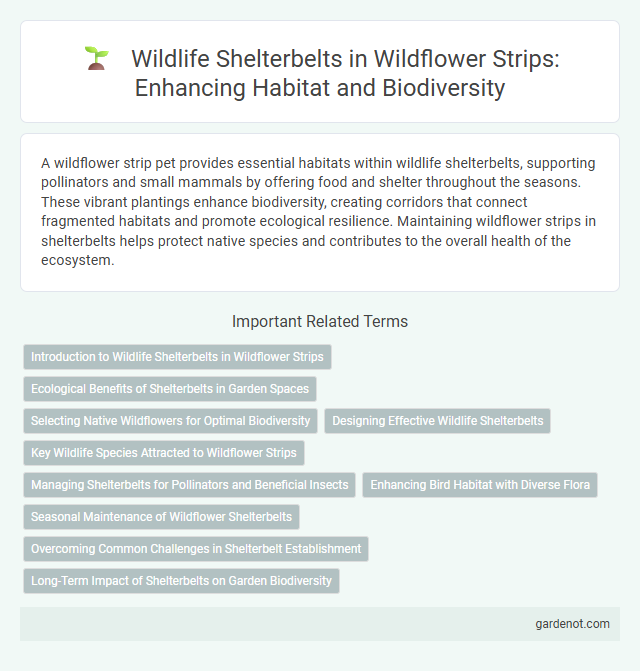A wildflower strip pet provides essential habitats within wildlife shelterbelts, supporting pollinators and small mammals by offering food and shelter throughout the seasons. These vibrant plantings enhance biodiversity, creating corridors that connect fragmented habitats and promote ecological resilience. Maintaining wildflower strips in shelterbelts helps protect native species and contributes to the overall health of the ecosystem.
Introduction to Wildlife Shelterbelts in Wildflower Strips
Wildlife shelterbelts in wildflower strips create essential habitats by providing native flora that supports pollinators, birds, and small mammals. These shelterbelts improve biodiversity, enhance soil stability, and contribute to microclimate regulation within agricultural landscapes. Integrating wildflower strips as shelterbelts promotes ecological balance and strengthens ecosystem resilience.
Ecological Benefits of Shelterbelts in Garden Spaces
Wildflower strips serve as effective wildlife shelterbelts by providing essential habitat and food sources for pollinators, birds, and beneficial insects, enhancing biodiversity in garden spaces. These shelterbelts improve soil quality and moisture retention, reduce wind erosion, and create microclimates that support plant growth. Incorporating native wildflower species maximizes ecological benefits by attracting diverse fauna and promoting a balanced garden ecosystem.
Selecting Native Wildflowers for Optimal Biodiversity
Selecting native wildflowers such as Echinacea purpurea, Solidago canadensis, and Asclepias tuberosa enhances the ecological value of wildlife shelterbelts by supporting local pollinators and bird species. Choosing region-specific species ensures better adaptation to soil and climate conditions, promoting resilient plant communities that contribute to biodiversity. Incorporating a diverse mix of native wildflowers creates a multilayered habitat structure essential for insects, small mammals, and avian wildlife.
Designing Effective Wildlife Shelterbelts
Designing effective wildlife shelterbelts involves selecting native plant species that provide year-round cover, food resources, and nesting sites for diverse animal populations. Incorporating multiple vegetation layers, such as tall trees, shrubs, and herbaceous plants, enhances structural complexity and supports different wildlife needs. Strategic placement near water sources and migration corridors maximizes shelterbelts' benefits for conserving biodiversity and mitigating habitat fragmentation.
Key Wildlife Species Attracted to Wildflower Strips
Wildflower strips serve as vital wildlife shelterbelts, attracting key species such as bees, butterflies, and small mammals that depend on native plants for food and habitat. Pollinators like bumblebees and monarch butterflies benefit immensely from the diverse nectar sources provided by these strips, enhancing local biodiversity and ecosystem health. Small birds and insects also rely on wildflower strips for cover and breeding grounds, boosting population stability of essential wildlife in agricultural landscapes.
Managing Shelterbelts for Pollinators and Beneficial Insects
Managing shelterbelts as wildlife habitats involves planting diverse native wildflower strips that provide essential forage and nesting sites for pollinators such as bees and butterflies. Incorporating a variety of flowering plants ensures continuous bloom periods, supporting beneficial insects throughout the growing season. Proper maintenance practices, including selective mowing and avoiding pesticide use, enhance the shelterbelt's effectiveness in promoting biodiversity and ecosystem health.
Enhancing Bird Habitat with Diverse Flora
A wildflower strip planted as a wildlife shelterbelt significantly enhances bird habitat by providing diverse flora that offers essential food sources such as seeds, berries, and nectar, attracting a variety of bird species. The structurally varied vegetation supports nesting opportunities and shelter from predators, promoting bird diversity and breeding success. Integrating native wildflowers, shrubs, and grasses creates a resilient ecosystem that sustains birds throughout seasonal changes.
Seasonal Maintenance of Wildflower Shelterbelts
Seasonal maintenance of wildflower shelterbelts involves timely pruning and removal of invasive species to promote native plant growth and biodiversity. Monitoring soil moisture and applying mulch during dry periods enhance plant resilience and support pollinator habitats. Regular inspections for pest infestations and diseases ensure the long-term health of wildflower shelterbelts, contributing to effective wildlife habitat conservation.
Overcoming Common Challenges in Shelterbelt Establishment
Establishing a wildlife shelterbelt involves overcoming challenges such as soil erosion, water scarcity, and invasive species management to ensure optimal habitat conditions. Selecting native drought-resistant wildflower species enhances resilience and supports biodiversity, while implementing erosion control techniques preserves soil health. Regular monitoring and adaptive management promote growth success and long-term ecosystem benefits in shelterbelt environments.
Long-Term Impact of Shelterbelts on Garden Biodiversity
Wildlife shelterbelts enhance garden biodiversity by creating microhabitats that support diverse flora and fauna, contributing to increased species richness over time. These shelterbelts reduce wind speed, moderate temperature fluctuations, and improve soil moisture retention, fostering optimal conditions for pollinators, birds, and beneficial insects. Long-term impacts include stabilized ecosystems, improved pollination rates, and enhanced resilience against environmental stressors for adjacent garden areas.
Wildlife shelterbelt Infographic

 gardenot.com
gardenot.com